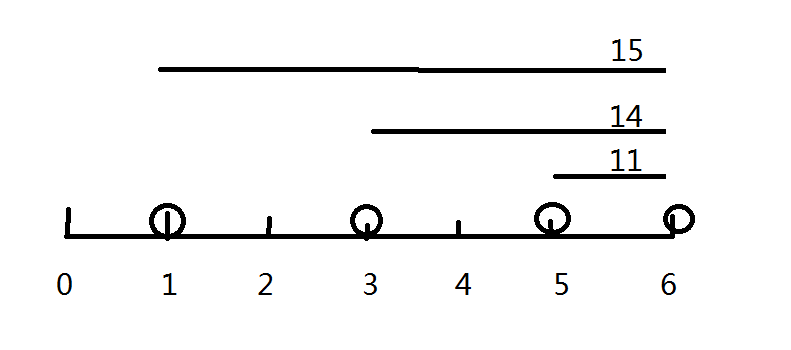测评传送门
题意:
n 头牛互相对着叫,每头牛有一个 耳背度ai,位置bi;
使得两头牛可以互相听见需要的音量 abs(bi - bj)*max(ai , aj)
求所有牛可以互相听见的总音量
input
4
3 1
2 5
2 6
4 3
output
57
思路:
n方的暴力做法很显然,也很好写,但必挂!
于是就需要用数据结构来优化,我们采用树状数组。
n方做法复杂在于,每选定两个数,都需要比较谁更耳背,但是好在距离可以O(1) 得出。
耳背最大的牛对于其他牛来说肯定是选用它的耳背度,那我们以耳背排序,是不是就省去了判耳背的过程?
但问题又来了,间距又不好算了。
树状数组就在这时发挥作用啦 ~
我们先以坐标排序,用树状数组维护他们的坐标总和,像这样:

通过树状数组可以帮助我们维护区间信息,本题我们用它来维护区间坐标和、区间点的数量
麻烦的地方在于如何通过这些信息来O(1)地求出当前最耳背的牛和其他牛之间的 SUM(abs(pos))
以图中的样例为例:
当前最耳背的牛在 3 位置,设SUM为他到其他牛的间距和
SUM=(3-1)+(5-3)+(6-3)
我们发现在它后面的牛可以直接减去3,而它前面的牛则需倒过来取绝对值
设后缀的间距和为BAK,前缀间距和为PRE
BAK=SUM(2~4)-num(2~4)*pos(2)
PRE=pos(2)*num(1~2)-SUM(1~2)
代码表示:
BAK = quer(4,0)-quer(2,0) - pos(2)*( quer(4,1)-quer(2,1) )
PRE = pos(2)*quer(2,1) - quer(2,0)
ANS = (BAK+PRE)*val
code
#include<stdio.h> #include<algorithm> #define lowbit(x) x&(-x) #define ll long long using namespace std; const int MXN=21000; struct node { int id,pos,val; }a[MXN]; int n,c[MXN][2]; ll ans; bool cvp(const node &p,const node &q) {return p.val<q.val;} bool cop(const node &p,const node &q) {return p.pos<q.pos;} void add(int x,int k,int d) { while(x<=n) { c[x][k]+=d; x+=lowbit(x); } } int quer(int x,int k) { int re=0; while(x) { re+=c[x][k]; x-=lowbit(x); } return re; } int main() { scanf("%d",&n); for(int i=1;i<=n;++i) { scanf("%d%d",&a[i].val,&a[i].pos); add(i,1,1); } sort(a+1,a+1+n,cop); for(int i=1;i<=n;++i) { a[i].id=i; add(i,0,a[i].pos); } sort(a+1,a+1+n,cvp); for(int i=n;i;--i) { add(a[i].id,1,-1); add(a[i].id,0,-a[i].pos); ans+=(long long)a[i].val*( quer(n,0) - 2*quer(a[i].id,0) + a[i].pos*( quer(a[i].id,1)*2 - quer(n,1)) ); } printf("%lld",ans); return 0; }